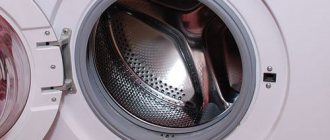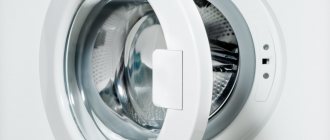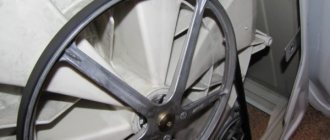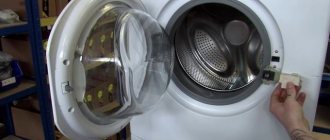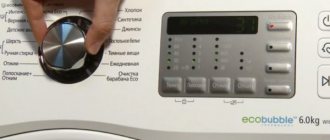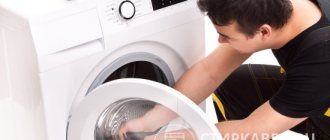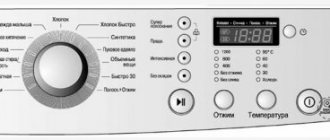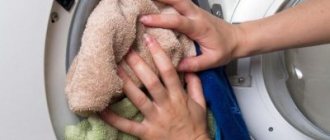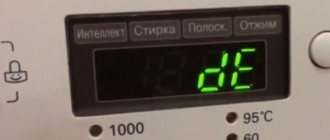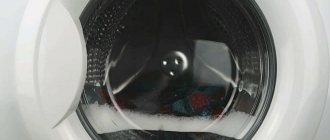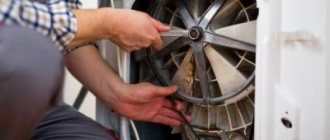If the drum of the washing machine begins to wobble during the spin process or from rocking when it is turned off, then there is no reason for premature worry. The machine tank, together with the drum, is suspended on springs at the top, and at the bottom has supports in the form of shock absorbers.
This allows the entire structure to move in three possible directions. And if the drum dangles during the spinning process, you should not compare this with a catastrophic problem. You probably overloaded your SMA, and it had to respond with chatter.
Additional signs of concern
A breakdown should be suspected if the drum play during spinning begins to be accompanied by certain symptoms:
- the unit rattles, and most of all - when spinning clothes;
- during the spin process, the drum begins to knock on the body part or on the glass loading hatch;
- the washing machine begins to jump or vibrate;
- The drive belt constantly falls off;
- the drum begins to rub against the cuff of the loading door;
- at first glance, the machine works normally, but the rotating drum makes squeaks and other noises;
- oily traces are visible under the unit;
- the machine begins to leak, there are traces of rust on the tank behind the rear panel;
- laundry is stained with oil or rust;
- the drum dangles a lot, then flies off and falls to the bottom;
- the washing machine chews the laundry;
- the drum jams and turns with difficulty, producing a metallic grinding sound;
- during operation, plugs are knocked out, smoke appears from the machine;
- The drum of the device is skewed.
Such a loose element, along with any symptoms, begins to signal a significant breakdown. And even in the case when the machine executes all programs, its operation is not recommended. When the drum of a washing machine dangles, more serious problems can be expected in the near future, including complete disposal of the device.
When to worry - additional signs
A malfunction should be suspected only when play in the washing machine drum is accompanied by the following additional symptoms, one or more:
- The washing machine makes a lot of noise, especially during the spin cycle.
- During the spin cycle, the drum knocks on the SMA body or on the glass of the hatch
- The machine jumps or vibrates strongly during the spin cycle
- The belt regularly falls off the pulley
- The drum rubs against the hatch cuff
- The machine seems to wash and spin normally, but it makes noise or creaks when the drum rotates
- Traces of an oily dark liquid are visible under the washing machine
- SM leaks from below, if you remove the back wall, rusty traces of leaks are visible on the tank
- The washing machine stains the laundry with black oil or rust stains
- The washing machine drum flew off and fell to the bottom of the tank
- The drum is jammed and rotates heavily with a metallic grinding noise.
- SMA chews on things
- The washing machine breaks plugs or smokes
- SM drum warped
Attention! A loose drum in combination with any of the listed symptoms indicates a serious malfunction. Even if the machine fully performs all cycles of the program, we do not recommend its operation. This will lead to more serious malfunctions, including the equipment being written off as scrap.
Causes of breakdowns and the procedure for determining them
A certain percentage of play is built into the washing machine by the manufacturer; this is considered normal. And there is no extraneous noise. But when the conversation turns to a breakdown, you need to act as follows:
- The loading hatch of the washing machine opens, then you should grab the drum with your hands, moving it to the sides without much effort. After this, it must be twisted clockwise and in the opposite direction. If you notice a grinding sound, these are the initial signs of a problem.
- Turn on the washing machine and set the “spin” program to the highest limits. When chatter occurs during rapid rotation, it feels as if the drum has been thrown off its own axis, and loud noises are heard again. Why does this happen? Look for a problem in the bearing or shock absorbers.
- To reliably clarify the failure, it is necessary to inspect the bottom of the machine. In most cases, failure of bearing devices is accompanied by water leakage through moving parts located on an invisible part of the tank. There is a high probability that at the end of the wash a large puddle will appear under the machine. This means that it is high time to replace the seals and bearings.
- When significant knocking noises are heard, but there is no water leakage, the bearings should not be changed - check the shock-absorbing devices. And getting to them is much easier.
The initial stage, which does not involve disassembling the unit, will not help determine anything else. It is possible to finally understand where the problem lies only after penetrating under the body part.
Failure of springs and shock absorbers is usually recognized quickly. They are simply examined thoroughly, shaking them a little. If at least one failed spring is detected, or a broken shock absorber is found, we can assume that the breakdown has been identified and disassembling the tank itself will not be required. And if everything is in order with such elements, then you will have to disassemble the machine further to remove the tank.
Causes of failure and how to determine them?
Some play in the washing machine drum is provided by the manufacturer , so if you grab its walls and shake it, it will sway a little from side to side - this is normal. In this case, no loud knocking sounds will be heard. It’s another matter if we are talking about a breakdown, to find out, do the following first.
- Open the hatch cover of the washing machine, grasp the drum with your hands and move it from side to side without any extra effort, and then rotate the drum clockwise and counterclockwise. If you hear a fairly loud knock or grinding noise, this is the first sign of a breakdown.
- Turn on the washing machine and set the spin program to the highest possible speed (usually 1000, 1200, 1400 rpm). If, during rapid rotation, the drum dangles a lot, there is a feeling that it has flown off the axis and all this is again accompanied by pronounced loud sounds - this is either a breakdown of the bearing or shock absorber.
- To check for damage, look under the bottom of the washing machine. Typically, bearing problems are accompanied by water leaking through a moving element located on the rear wall of the tank. There is a high probability that a puddle will accumulate under the machine after washing; this will mean only one thing - you need to change the seals and drum bearings.
- If there is a strong knocking sound, but no water is leaking, it is better not to go to the bearings for now, but check the shock absorbers. They are much easier to reach.
Note! When rotating the washing machine drum, pay attention to how easily or hard it turns. If the drum rotates clearly hard, it seems that it has fallen off - this is an indirect sign of bearing failure.
At the initial stage, without disassembling the washing machine, it is impossible to find out anything more. It is impossible to determine exactly what is broken in the car without opening the case, so to clarify the problem, we will remove its top cover and take a look.
Faulty spring suspensions or shock absorbers are usually easy to recognize. It is enough to examine them carefully, or even better, shake them slightly. If at least one faulty spring suspension or shock absorber is found, then consider that the breakdown has been found and there is no need to disassemble the tank to repair the bearings. If the suspensions and shock absorbers are in good working order, then you will have to climb further into the car and remove the tank from it.
What is required for DIY repairs?
The set of tools and components for repairing a loose drum will depend purely on the nature of the breakdown. If you need to replace shock absorbers or springs, then it is enough to get a flat-head and Phillips screwdriver, an awl, a set of keys and, accordingly, a set of shock absorbers or springs suitable for this model of “washer”. But if you need to change the bearings, then you will need a few more tools and components:
- hammer with copper striker;
- steel rod or pin;
- cold welding or sealant;
- awl, flathead and Phillips screwdrivers;
- set of heads and open-end wrenches;
- pliers;
- specialized lubricant for washing machine mechanisms;
- a set of bearings and seals for a specific model of washing machine.
We will need a hammer with a copper striker to more delicately remove the shaft from the washing machine drum pin, since it is precisely such a striker that allows us to avoid damaging delicate parts. A steel rod or pin or other suitable device is needed to knock the bearings out of their seat. In essence, it does not matter what the device will be, the main thing is that it is suitable in length, thickness and consists of metal.
Cold welding or sealant may be required if a certain model of washing machine has a non-separable tank. In this case, in order to disassemble the tank, it is sawed across the seam and then connected using self-tapping screws and cold welding. Using an awl, it is convenient to pry up the oil seals and pull out old oil seals , and screwdrivers are useful for unscrewing fasteners, as is a set of sockets and open-end wrenches. Special lubricant will be required to fill the oil seals and lubricate the shock absorbers.
Important! If you decide to change bearings, don’t skimp, change them all as a set. Then you will have less to climb into the body of the car and do it.
How to replace a bearing in a machine
To carry out such repair work, it is necessary to remove the rear housing cover, disconnect the drum from the motor shaft, and sometimes remove the electric motor. Due to the fact that during assembly the bearing is firmly pressed into the mount, it must be knocked out. In a number of models, it is possible to dismantle the crosspiece, and sometimes you have to remove the tank itself.
Particularly difficult are cases where the washing machine has a solid tank made of plastic or composite material. To access the drum, you have to cut it. Instead of the dismantled broken bearing, a new analogue is installed, then the machine is checked for rotation and the rigidity of the drum fastening, and assembly is performed in the reverse order. You can organize a trial run to test the device.
Replacing bearings in a washing machine
To replace the bearings, you will have to remove the back panel of the machine body, disconnect the drum axis from the motor shaft, and in some models, remove the electric motor. Since the bearing is firmly pressed into the mount during assembly, it will have to be knocked out. In some car models it is possible to remove the crosspiece, in some you have to completely remove the tank.
Particularly difficult are cases when the washing machine has a one-piece welded composite or plastic tank. To access the drum you will have to cut it. A new one is installed in place of the removed inoperative bearing, after which the rotation and rigidity of the drum installation are checked, reassembly is carried out and the machine is tested.
How to replace a shock absorber
This element, like spring hangers, cannot be restored. A specialist will install new ones for you. Temporary measures will not help in such situations. You will have to remove the housing cover, loosen and remove the springs one by one to inspect the fastening points for integrity.
When the tank is freed, you can remove and change the shock absorbers, and hang the tank in its original place. If the old springs have lost their elasticity, they are replaced with new analogues. By the way, when performing work, the master must check the condition of the tank and the supporting bearing cross.
The repair is completed with assembly and testing.
There is a foreign object in the drum
During the washing process you can hear knocking and rumbling noises. Sometimes the cause of this is an object that accidentally ends up in the drum. Often this phenomenon is caused by a break in the shock absorber or spring from the main frame.
During vibration and rocking, the broken element begins to knock on the body and tank quite rhythmically. It may appear that there is an object in the drum. If the element has completely fallen off, the roar will not be very rhythmic, and the drum will sway in a certain direction.
A distinctive sign of suspension problems is the drum swaying at low speeds during washing. Deviation from the axial will immediately catch the eye, and a strong knock will be heard on the body part. It is possible to identify problems with such negative manifestations only through a serious inspection of the device.
There is a foreign object dangling in the washing machine
While the washing machine is operating, you may notice knocking and rattling noises. Sometimes it is caused by a foreign object getting into the tank or drum. Most often, this phenomenon is associated with the separation of the shock absorber or spring from the base on the frame of the machine.
With vibration and increased rocking, the detached part knocks on the body and tank quite rhythmically, and it seems to you that something foreign has got into the drum. If the part comes off completely, then the rumble may not be so noticeable and rhythmic, but you will notice a clear swing of the drum in one direction.
A characteristic sign of suspension problems is the drum swaying at low speeds in the washing mode. The deviation from the axis will be noticeable, and over time you will hear a knock from impacts on the body. The origin and consequences of these faults can only be determined during serious diagnostics.
Tools needed for repair work
It all depends on the type of damage. If you need to change shock-absorbing elements or springs, then all you need are flat-head and Phillips screwdrivers, an awl, some keys and a repair kit suitable for this model. And if bearings need to be changed, then a wider range of items will be needed:
- hammer with a striking part made of copper;
- rod or pin made of steel material;
- sealant (cold welding);
- set of screwdrivers and awl;
- open-end wrenches and a set of socket heads;
- pliers;
- special lubricant for washing machine parts;
- bearings and seals included.
The shaft is removed from the drum pin with a copper hammer, because this type of striker will not damage the part. A steel rod or other suitable device is needed to knock the bearings out of their seats. The main thing is that such a device must be long and suitable in thickness.
Welding or sealant will be needed when in some model of washing machine the tank turns out to be one-piece. It will have to be sawed along the seam, then the connection will be made. Using an awl, the stuffing box elements are pryed up, pulled out, all fasteners are unscrewed with screwdrivers; keys are needed for the same purpose. Lubricant is applied to shock-absorbing elements and seals.
How to fix a washing machine drum if it's loose
Before you fix a machine with a loose drum, gather your tools. If the repair consists only of replacing springs or shock absorbers, then you will need a little:
- flat and Phillips screwdrivers;
- awl;
- keys;
- repair pair kit.
But to replace bearings you need more tools:
- Repair kit (bearings, seals).
- Hammer with copper striking part. You will need it to delicately remove the shaft and not damage fragile parts.
- Metal pin. With its help you can knock out the bearings. A steel rod or any similar device will do.
- “Cold welding” or silicone sealant. You will need them if your SM model has a non-separable tank - then it will have to be glued together.
- A hacksaw will be needed for the same reason as the sealant.
- An awl will help you pry and remove the old seals.
- Two screwdrivers: negative and positive will unscrew the fasteners, of which you will find many during disassembly of the washing machine.
- For the same purpose, you will need a set of keys and sockets.
- Pliers.
- Lubricant for new elements.
Attention! Change both bearings at once so that after a while you don’t have to disassemble the machine again.
Replace bearings
To correctly replace parts, you need to properly disassemble the housing. The catch is that washing machines from different manufacturers are disassembled differently. You can get the tank through the top panel in the following brands: Zanussi, Atlant.
Through the front panel we take out the tank in SM Samsung, Ariston, LG, Indesit, Bosch and Siemens. Some machines (for example, Electrolux) are disassembled into two parts, but the tank is also removed through the front cover.
Read more about disassembling a washing machine to replace bearings in the following articles: How to replace a bearing in a washing machine drum, in a Bosch, Electrolux, Zanussi machine.
How causes are identified in machines from various companies
Minor drum chatter in Ariston, Kandy, Bosch, LG or Samsung washing machines is provided for by the manufacturer from the very beginning. Backlash is necessary for the normal functioning of the device. But such rocking of the drum does not cause the formation of extraneous knocks during the washing process. But when they are heard during the spin cycle, it is recommended to take a number of actions:
- open the loading door, grab the drum with your hands, and twist it. If you hear a grinding sound, look for the problem;
- Indesit starts with an empty drum at maximum. If during rotation there is a feeling of large vibrations accompanied by noise, then it is necessary to inspect the bearings or shock-absorbing devices;
- pay attention to water that may leak from the machine;
- If you hear a grinding noise but cannot find a leak, replace the shock absorbers.
Why does the drum shake?
- The bearings are damaged.
- The shock absorbers are broken.
- The crosspiece is cracked.
- A foreign object is stuck in the tank.
These reasons cause increased play in the machine. To correctly diagnose the problem, pay attention to the characteristics of the looseness and the size of the gap.
How to check play
Spin the empty cylinder by hand. If it creaks when moving and touches the tank, it means the bearing has become loose. A broken bearing also causes leakage during the washing process.
Pull the drum towards you and release it. If it wobbles a lot, sways, falls out, sinks, or spontaneously separates from the cuff, the shock absorbers have failed.
When the drum moves, does the body shake, twist sharply, does it seem like the machine has “gone crazy”? Most likely the crosspiece is cracked.
The movements are smooth and silent, but is there something rattling and rattling on the walls? It looks like a small object is stuck in the tank. If you know how to use tools, you can fix these troubles at home.
Advice from the experts
If there is a problem with a bearing or shock-absorbing device, then all elements should be replaced, because a failed part will soon lead to a chain of problems from its analogues. And when you have disassembled the washing device, immediately change the seals, which also have operating limitations and wear out quite quickly.
Remember that machines from different manufacturers differ in their design and are disassembled in different ways. This feature should also be taken into account when undertaking repair work on your own.
Disassembling the unit tank and removing the bearings must be done correctly. There are washing machines in which it is possible to get to the shock absorber through the top of the machine or through its bottom. This convenient feature helps save time during repairs - you don’t have to remove the panels.
